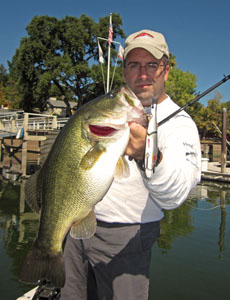Lure manufacturers invest loads of time, effort and resources to develop the next latest-and-greatest. Enticing wiggles, erratic darting, just the right amount of rattle and flash – how a bait moves accounts for the lion’s share of this attention.
Notwithstanding the fact that many of these developments are intended as much to catch fishermen as fish, the tackle industry’s R&D machine is certainly a necessary mechanism. That being said, the best action is sometimes no action.
The term is dead-sticking, and although we often associate this technique with dropping a piece of soft plastic to the bottom, the strategy can actually apply to a variety of baits – both hard and soft. Now, a thorough treatise on the dead-stick premise could fill multiple articles, so let me just offer a couple of examples I encountered while covering an EverStart Western Division tournament on Northern California’s Clear Lake.
The first example is pretty straightforward – dropshotting. It’s often said that the best way to work a drop shot is to not work it. Just let the bait move naturally in the water.
I spent a practice day snapping up bass pics with iRod president and EverStart pro Matt Newman. A little before noon, we linked up with local stick Paul Bailey and co-angler standout Lester Albury to compare notes and diversify the photo shoot. As I probed a grass line with a dropshot, Bailey described his preferred method for working this rig.
“I like to dead stick my dropshot,” he said. “I don’t like to drag it. I fish it in one place at a time and just let it sit there.”
Although not directly related, Bailey’s advice rang true in the tournament’s co-angler division, as Chad Leblanc won the deal by essentially dead-sticking a dropshot with a 6-inch Roboworm in (Margarita Mutilator) and a 3-inch leader over rocky bottom outside of Rodman Slough where pro division winner Michael C. Tuck was nabbing big bass on a swimbait. Tuck graciously allowed his partner sufficient time for the patient presentations and Leblanc picked off the ones that passed on the moving lure.
“The key was just letting it sit,” he said. “It was almost like we were catfishing. I just let it sit and they ate it. Mike let my bait sit in the zone for a long time and I was fortunate enough to catch five.”
Now that’s the remedial stuff. Here’s where it gets cool. Toward the end of our practice day, Newman and I slipped into a residential bay where voluminous schools of a large indigenous baitfish called “hitch” swarmed around docks and frequently showed signs of fleeing largemouth predation. Newman armed me with his iRod Jr. Swim rod and a segmented Gancraft swimbait, while he threw a soft-bodied model called Trashfish.
 While my host pointed the bow toward all the likely corner shot, I worked my bait off the stern, mostly casting parallel to dock faces and swimming the bait past the shadows to hopefully entice anyone lurking below. Middway through a well-aligned cast, I got a call from another angler, recent Forrest Wood Cup finalist Cody Meyer, with whom I was coordinating for a later photo shoot. Holding the phone in my left hand, I gripped the rod in my right and gave the bait a couple of upward twitches to keep it out of the grass. But as I focused more intently on the phone conversation, I paused the swimbait’s motion and the big hunk of plastic and metal sank through the surrounding baitfish and into the 6-foot depths.
While my host pointed the bow toward all the likely corner shot, I worked my bait off the stern, mostly casting parallel to dock faces and swimming the bait past the shadows to hopefully entice anyone lurking below. Middway through a well-aligned cast, I got a call from another angler, recent Forrest Wood Cup finalist Cody Meyer, with whom I was coordinating for a later photo shoot. Holding the phone in my left hand, I gripped the rod in my right and gave the bait a couple of upward twitches to keep it out of the grass. But as I focused more intently on the phone conversation, I paused the swimbait’s motion and the big hunk of plastic and metal sank through the surrounding baitfish and into the 6-foot depths.
Suddenly, my line came tight. The rod started to bend and I nonchalantly tugged the bait to free it from the grass.
The grass tugged back.
Fast forward through the predictable stuff and I had to call Cody back – he eventually hung up when I tossed my phone to the deck. My report: 6-pounder on the swimbait. The tactic: dead sticking.
Newman and I discussed the experience and he noted that a day earlier his regular practice partner had stuck a nice one on the same bait after killing it and letting it fall. Unintentionally, I had done the same thing. By pausing my motion, I let the bait sink like a dead or dying hitch.
Maybe that’s why bass will still bite in areas where the natural food is so thick they have endless options. Bottom line: You not only have to mimic the real stuff, you have to make your bait look like the easiest one to catch. Remember, these eternally lazy predators known as largemouth bass will follow the path of least resistance. Dead-sticking often fits this bill.
Through his professional writing business, Tight Line
Communications (www.tightwords.com),
David A. Brown offers journalism and marketing communication
services.

